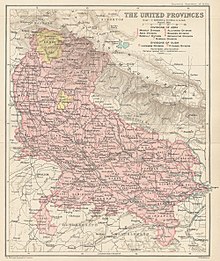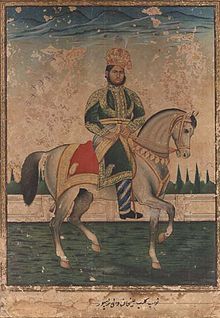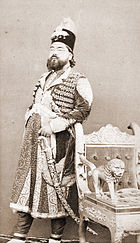Rampur State: Difference between revisions
mNo edit summary |
|||
| Line 38: | Line 38: | ||
== History== |
== History== |
||
{{main|Nawab of Rampur}} |
|||
The [[Rohilla War]] of 1774–5 began when the Rohillas reneged on a debt they owed the [[Nawab of Oudh]] for military assistance against the [[Marathas]] in 1772. The Rohillas were defeated and driven from their former capital of [[Bareilly]] by the Nawab of [[Oudh]] with the assistance of the [[British East India Company|East India Company]]'s troops. The Rohilla State of Rampur was established by [[Nawab Faizullah Khan]] on 7 October 1774 in the presence of British Commander Colonel Champion, and remained a pliant state under British protection thereafter. |
The [[Rohilla War]] of 1774–5 began when the Rohillas reneged on a debt they owed the [[Nawab of Oudh]] for military assistance against the [[Marathas]] in 1772. The Rohillas were defeated and driven from their former capital of [[Bareilly]] by the Nawab of [[Oudh]] with the assistance of the [[British East India Company|East India Company]]'s troops. The Rohilla State of Rampur was established by [[Nawab Faizullah Khan]] on 7 October 1774 in the presence of British Commander Colonel Champion, and remained a pliant state under British protection thereafter. |
||
Revision as of 13:17, 1 January 2016
- Not to be confused with Ranpur State
| Rampur State रामपुर रियासत / رام پور ریاست | |||||||||
|---|---|---|---|---|---|---|---|---|---|
| Princely State of British India | |||||||||
| 1774–1949 | |||||||||
 Rampur State in a Map of the United Provinces from The Imperial Gazetteer of India (1907-1909) | |||||||||
| Area | |||||||||
• 1941 | 2,310 km2 (890 sq mi) | ||||||||
| Population | |||||||||
• 1941 | 477,042 | ||||||||
| Government | |||||||||
| • Motto | Lā fata ʾillā ʿAlī; lā sayf ʾillā Ḏū l-Fiqār. | ||||||||
| History | |||||||||
• Established | 1774 | ||||||||
| 1949 | |||||||||
| |||||||||
| Today part of | Uttar Pradesh, India | ||||||||
This article incorporates text from a publication now in the public domain: Chisholm, Hugh, ed. (1911). Encyclopædia Britannica (11th ed.). Cambridge University Press. {{cite encyclopedia}}: Missing or empty |title= (help) | |||||||||



Rampur State was a 15 gun-salute princely state of British India. It came into existence on 7 October 1774 as a result of a treaty with Oudh. Following independence in 1947, Rampur State and other princely states of the area, such as Benares and Tehri-Garwal were merged into the United Provinces.[1] Rampur state had its capital in Rampur town and its total area was 945 sq miles.[2]
History
The Rohilla War of 1774–5 began when the Rohillas reneged on a debt they owed the Nawab of Oudh for military assistance against the Marathas in 1772. The Rohillas were defeated and driven from their former capital of Bareilly by the Nawab of Oudh with the assistance of the East India Company's troops. The Rohilla State of Rampur was established by Nawab Faizullah Khan on 7 October 1774 in the presence of British Commander Colonel Champion, and remained a pliant state under British protection thereafter.
Faizullah Khan was a syed among the pashtuns and belonged to the syed people. His family migrated and settled in Hindustan (now India) during the Mughal Empire. The Pashtuns consisted of high ranking soldiers and administrative elites of the Mughal Empire. Rampur State was one of the important princely states in Hindustan.
The first stone of the new Fort at Rampur was laid and the city of Rampur founded in 1775 by Nawab Faizullah Khan. Originally it was a group of four villages named Kather, the name of Raja Ram Singh. The first Nawab proposed to rename the city 'Faizabad'. But many other places were known by the name Faizabad so its name was changed to Mustafabad alias Rampur. Nawab Faizullah Khan ruled for 20 years. He was a great patron of scholarship, and began the collection of Arabic, Persian, Turkish and Urdu manuscripts which now make up the bulk of the Rampur Raza Library. After his death his son Muhammad Ali Khan took over, but he was killed by the Rohilla leaders after 24 days, and Ghulam Muhammad Khan, the brother of the deceased, was proclaimed Nawab. The East India Company took exception to this, and after a reign of just 3 months and 22 days Ghulam Muhammad Khan was defeated by its forces, and the Governor-General made Ahmad Ali Khan, son of the late Muhammad Ali Khan, the new Nawab. He ruled for 44 years. He did not have any sons, so Muhammad Sa'id Khan, son of Ghulam Muhammad Khan, took over as the new Nawab. He raised a regular Army, established Courts and carried out many works to improve the economic conditions of farmers. His son Muhammad Yusuf Ali Khan took over after his death. His son Kalb Ali Khan became the new Nawab after his death in 1865.
Nawab Kalb Ali Khan was literate in Arabic and Persian. Under his rule the state did much work to uplift standards of education. He was also a Member of Council during the Viceroyalty of Lord John Lawrence. He built the Jama Masjid in Rampur at a cost of Rs. 300,000. He was also knighted in Agra by the Prince of Wales. He ruled for 22 years and 7 months. After his death his son Mushtaq Ali Khan took over. He appointed W. C. Wright as the Chief Engineer of the estate. He built many new buildings and canals. Nawab Hamid Ali became the new ruler in 1889 at the age of 14. Many new schools were opened during his reign, and lots of donations were provided to nearby colleges. He donated Rs. 50,000 to Lucknow Medical College. In 1905 he built the magnificent Darbar Hall within the Fort which now houses the great collection of Oriental manuscripts held by the Rampur Raza Library. His son Raza Ali Khan became the last ruling Nawab in 1930. On 1 July 1949 the State of Rampur was merged into the Republic of India. Rampur today presents a slightly decayed appearance: the palaces of the Nawabs are crumbling, as are the gates and walls of the fort. However, the Library remains a flourishing institution of immense value to scholars from all over the world.
The Nawabs of Rampur sided with the British during the India's First War of Independence in 1857[3] and this enabled them to continue to play a role in the social, political and cultural life of Northern India in general and the Muslims of United Provinces in particular. They gave refuge to some of the literary figures from the Court of Bahadur Shah Zafar.
Music
The Nawabs of Rampur gave patronage to traditionalmusic in their court. Mehboob Khan was the chief khyal singer of the royal court of Rampur State, his tradition was followed by his son Inayat Hussain Khan (1849–1919) and in turn by Inyat's brother-in-laws, Haider Khan (1857-1927), and Mushtaq Hussein Khan (d. 1964), which gave rise to the Rampur-Sahaswan gharana of Hindustani classical music, the latter being their ancestral place, Sahaswan, in present Badaun district.[4]
Post independence
Important descendants of the Nawabs include Murad Mian the first child of Murtaza Ali Khan Bahadur of Rampur.
Begum Noor Bano, the widow of the former Nawab, Zulfiquar Ali Khan of Rampur. Begum Noor Bano has become a politician and won the election from Rampur parliamentary constituency in 1999. She lost the elections in 2004 and 2009. Murtaza Ali Khan and Zulfiquar Ali Khan (aka Mikki Mia), who continued to use the title of Nawab as a token even after independence and abolition of royalty but never ruled Rampur, are now dead. Murtaza Ali contested an election from Rampur opposite his mother Rafat Jamani Begum in 1972 and won. Although the two brothers were always political rivals they never faced each other in elections. Subsequently, the family was also involved in smuggling scandals involving some smuggling from Pakistan, where one of the sons of Murtaza Ali is married. Raza Inter College, Hamid Inter College and Murtaza Inter College are three higher secondary schools named after three nawabs.
Rulers of Rampur

| Name | Reign Began | Reign Ended | |
|---|---|---|---|
| 1 | Faizullah Khan | 15 September 1748 | 24 July 1793 |
| Hafiz Rahmat Khan - Regent | 15 September 1748 | 23 April 1774 | |
| 2 | Muhammad Ali Khan Bahadur | 24 July 1793 | 11 August 1793 |
| 3 | Ghulam Muhammad Khan Bahadur | 11 August 1793 | 24 October 1794 |
| 4 | Ahmad Ali Khan Bahadur | 24 October 1794 | 5 July 1840 |
| Nasrullah Khan - Regent | 24 October 1794 | 1811 | |
| 5 | Muhammad Said Khan Bahadur | 5 July 1840 | 1 April 1855 |
| 6 | Yusef Ali Khan Bahadur | 1 April 1855 | 21 April 1865 |
| 7 | Kalb Ali Khan Bahadur | 21 April 1865 | 23 March 1887 |
| 8 | Muhammad Mushtaq Ali Khan Bahadur | 23 March 1887 | 25 February 1889 |
| 9 | Hamid Ali Khan Bahadur | 25 February 1889 | 20 June 1930 |
| Regency | 25 February 1889 | 4 April 1894 | |
| 10 | Raza Ali Khan Bahadur | 20 June 1930 | 6 March 1966 |
| 11 | Murtaza Ali Khan Bahadur - Nawabat abolished in 1971 | 6 March 1966 | 8 February 1982 |
| 12 | Zulfikar Ali Khan Bahadur -Nawabat abolished in 1971 | 8 February 1982 | 5 April 1992 |
| 13 | Syed Kazim Ali Khan -Nawabat abolished in 1971 | 5 April 1992 | Till Date |
italics-titulary reigns
Family tree
 I. Sayyid Faizu’llah ‘Ali Khan Bahadur, Nawab of Rampur (1734-1794; Nawab of Rampur: 1734-1794)
I. Sayyid Faizu’llah ‘Ali Khan Bahadur, Nawab of Rampur (1734-1794; Nawab of Rampur: 1734-1794)
 II. Sayyid Muhammad Ali Khan Bahadur, Nawab of Rampur (1751-1794; r. 1794)
II. Sayyid Muhammad Ali Khan Bahadur, Nawab of Rampur (1751-1794; r. 1794)
 III. Hajji Sayyid Ghulam Muhammad Khan Bahadur, Nawab of Rampur (1763-1823; r. 1794)
III. Hajji Sayyid Ghulam Muhammad Khan Bahadur, Nawab of Rampur (1763-1823; r. 1794)
 V. Sayyid Muhammad Said Khan Bahadur, Nawab of Rampur (1786-1855; r. 1840-1855)
V. Sayyid Muhammad Said Khan Bahadur, Nawab of Rampur (1786-1855; r. 1840-1855)
 VI. Sayyid Muhammad Yusef Ali Khan Bahadur, Nawab of Rampur KSI (1816-1865; r. 1855-1865)
VI. Sayyid Muhammad Yusef Ali Khan Bahadur, Nawab of Rampur KSI (1816-1865; r. 1855-1865)
 VII. Hajji Sayyid Muhammad Kalb-i-Ali Khan Bahadur, Nawab of Rampur GCSI, CIE (1834-1887; r. 1865-1887)
VII. Hajji Sayyid Muhammad Kalb-i-Ali Khan Bahadur, Nawab of Rampur GCSI, CIE (1834-1887; r. 1865-1887)
 VIII. Sayyid Muhammad Mushtaq Ali Khan Bahadur, Nawab of Rampur (1856-1889; r. 1887-1889)
VIII. Sayyid Muhammad Mushtaq Ali Khan Bahadur, Nawab of Rampur (1856-1889; r. 1887-1889)
 IX. Sayyid Hamid Ali Khan Bahadur, Nawab of Rampur GCSI, GCIE, GCVO (1875-1930; r. 1889-1930)
IX. Sayyid Hamid Ali Khan Bahadur, Nawab of Rampur GCSI, GCIE, GCVO (1875-1930; r. 1889-1930)
 X. Sayyid Muhammad Raza Ali Khan Bahadur, Nawab of Rampur GCIE, KCSI (1908-1966; r. 1930-1949; titular ruler 1949-1966)
X. Sayyid Muhammad Raza Ali Khan Bahadur, Nawab of Rampur GCIE, KCSI (1908-1966; r. 1930-1949; titular ruler 1949-1966)
- XI. Sayyid Murtaza Ali Khan Bahadur MBE (1923-1982; titular ruler: 1966-1971; family head: 1971-1982)
- XII. Sayyid Zulfikar Ali Khan Bahadur, Nawab of Rampur (1933-1992; family head: 1982-1992)
- XIII. Sayyid Muhammad Kazim Ali Khan Bahadur, Nawab of Rampur (b. 1960; family head: 1992- )
- Nawabzada Sayyid 'Ali Muhammad Khan Bahadur (b. 1989)
- Nazabzada Sayyid Haider Ali Khan Bahadur (b. 1990)
- XIII. Sayyid Muhammad Kazim Ali Khan Bahadur, Nawab of Rampur (b. 1960; family head: 1992- )
Legacy
Dog breed

His Royal Highness Nawab Ahmad Ali Khan of Rampur is credited with developing the dog breed known as Rampur Hound. The Rampur Hound far exceeded his expectations. He endeavoured to breed these dogs by combining the Tazi ferocious Afghan dogs with the English Greyhound, more obedient but less resistant to the harsher local weather. He gave the name 'Rampur Hound' to the dogs he bred.[6]
Cuisine
The cuisine of the royal courts over the years gave rise to the Rampuri cuisine, developed by the chefs of the Nawabs. After the Indian Mutiny of 1857, the chefs, khansama from erstwhile Mughal imperial courts shifted to Rampur, bringing along with them the Mughal cuisine tradition,[7] gradually people other places also found a safe haven here, adding influences of Awadhi, Hyderabad and Kashmiri cuisine,[8] It is also known for its distinct flavours and dishes with recipes passed on from the royal kitchen, like Rampuri fish, Rampuri Korma, Rampuri mutton kebabs, doodhiya biryani and adrak ka halwa.[9][10][11]
Music
Mehboob Khan was the chief khyal singer of the royal court of Rampur State, his tradition was followed by his son Inayat Hussain Khan (1849–1919) and in turn by Inyat's brother-in-laws, Haider Khan (1857-1927), and Mushtaq Hussein Khan (d. 1964), which gave rise to the Rampur-Sahaswan gharana of Hindustani classical music, the latter being their ancestral place, Sahaswan, in present Badaun district.[12]
See also
References
- ^ Rampur State - Royalark
- ^ Hunter, William Wilson (1881). The imperial gazetteer of India. India. pp. 544–546. Retrieved 16 December 2013.
{{cite book}}: CS1 maint: location missing publisher (link) - ^ Rampur This article incorporates text from a publication now in the public domain: Chisholm, Hugh, ed. (1911). Encyclopædia Britannica (11th ed.). Cambridge University Press.
{{cite encyclopedia}}: Missing or empty|title=(help). - ^ Wade. p. 136
- ^ Rampur - family genealogy
- ^ Rampur Hound
- ^ "Kebabs, kings and other Rampuri tales". MiD DAY. 26 March 2013. Retrieved 29 May 2013.
- ^ "The Rampuri flavour: The Rampuri food festival at Mascot Hotel takes you on a voyage of discovery". The Hindu. 30 August 2004. Retrieved 29 May 2013.
- ^ "The culinary cartographer". Mint. 22 January 2010.
- ^ "Sharp cuts from the Rampuri !". Business Standard. 7 January 2007.
- ^ "Mutton Korma in Rampur". Indian Express. 28 August 2005.
- ^ Wade. p. 136
Bibliography
- Bonnie C Wade (1984). Khyāl: Creativity Within North India's Classical Music Tradition. Cambridge University Press Archive. ISBN 0521256593.
External links
 Media related to Rampur State at Wikimedia Commons
Media related to Rampur State at Wikimedia Commons


